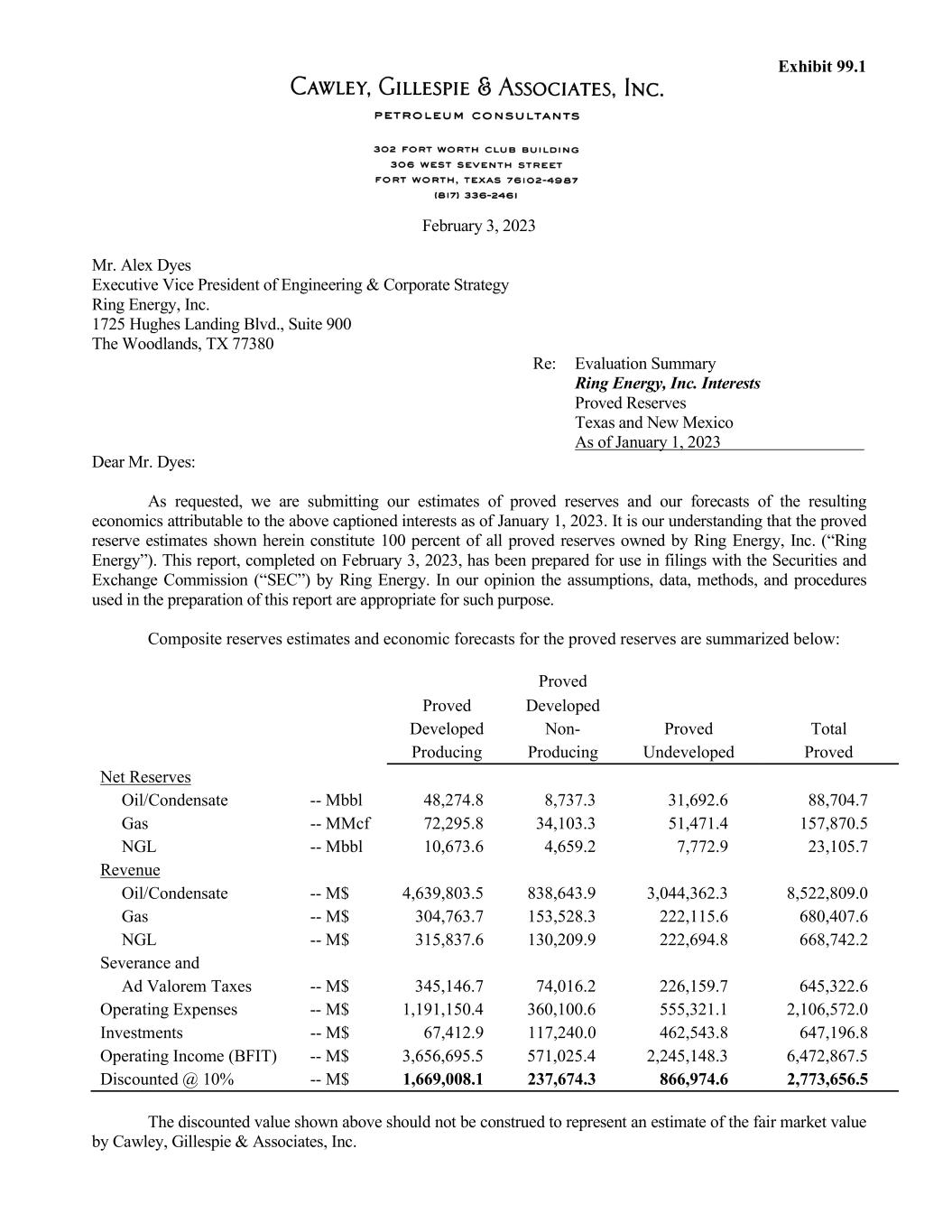
Exhibit 99.1 February 3, 2023 Mr. Alex Dyes Executive Vice President of Engineering & Corporate Strategy Ring Energy, Inc. 1725 Hughes Landing Blvd., Suite 900 The Woodlands, TX 77380 Re: Evaluation Summary Ring Energy, Inc. Interests Proved Reserves Texas and New Mexico As of January 1, 2023 Dear Mr. Dyes: As requested, we are submitting our estimates of proved reserves and our forecasts of the resulting economics attributable to the above captioned interests as of January 1, 2023. It is our understanding that the proved reserve estimates shown herein constitute 100 percent of all proved reserves owned by Ring Energy, Inc. (“Ring Energy”). This report, completed on February 3, 2023, has been prepared for use in filings with the Securities and Exchange Commission (“SEC”) by Ring Energy. In our opinion the assumptions, data, methods, and procedures used in the preparation of this report are appropriate for such purpose. Composite reserves estimates and economic forecasts for the proved reserves are summarized below: Proved Proved Developed Developed Non- Proved Total Producing Producing Undeveloped Proved Net Reserves Oil/Condensate -- Mbbl 48,274.8 8,737.3 31,692.6 88,704.7 Gas -- MMcf 72,295.8 34,103.3 51,471.4 157,870.5 NGL -- Mbbl 10,673.6 4,659.2 7,772.9 23,105.7 Revenue Oil/Condensate -- M$ 4,639,803.5 838,643.9 3,044,362.3 8,522,809.0 Gas -- M$ 304,763.7 153,528.3 222,115.6 680,407.6 NGL -- M$ 315,837.6 130,209.9 222,694.8 668,742.2 Severance and Ad Valorem Taxes -- M$ 345,146.7 74,016.2 226,159.7 645,322.6 Operating Expenses -- M$ 1,191,150.4 360,100.6 555,321.1 2,106,572.0 Investments -- M$ 67,412.9 117,240.0 462,543.8 647,196.8 Operating Income (BFIT) -- M$ 3,656,695.5 571,025.4 2,245,148.3 6,472,867.5 Discounted @ 10% -- M$ 1,669,008.1 237,674.3 866,974.6 2,773,656.5 The discounted value shown above should not be construed to represent an estimate of the fair market value by Cawley, Gillespie & Associates, Inc.
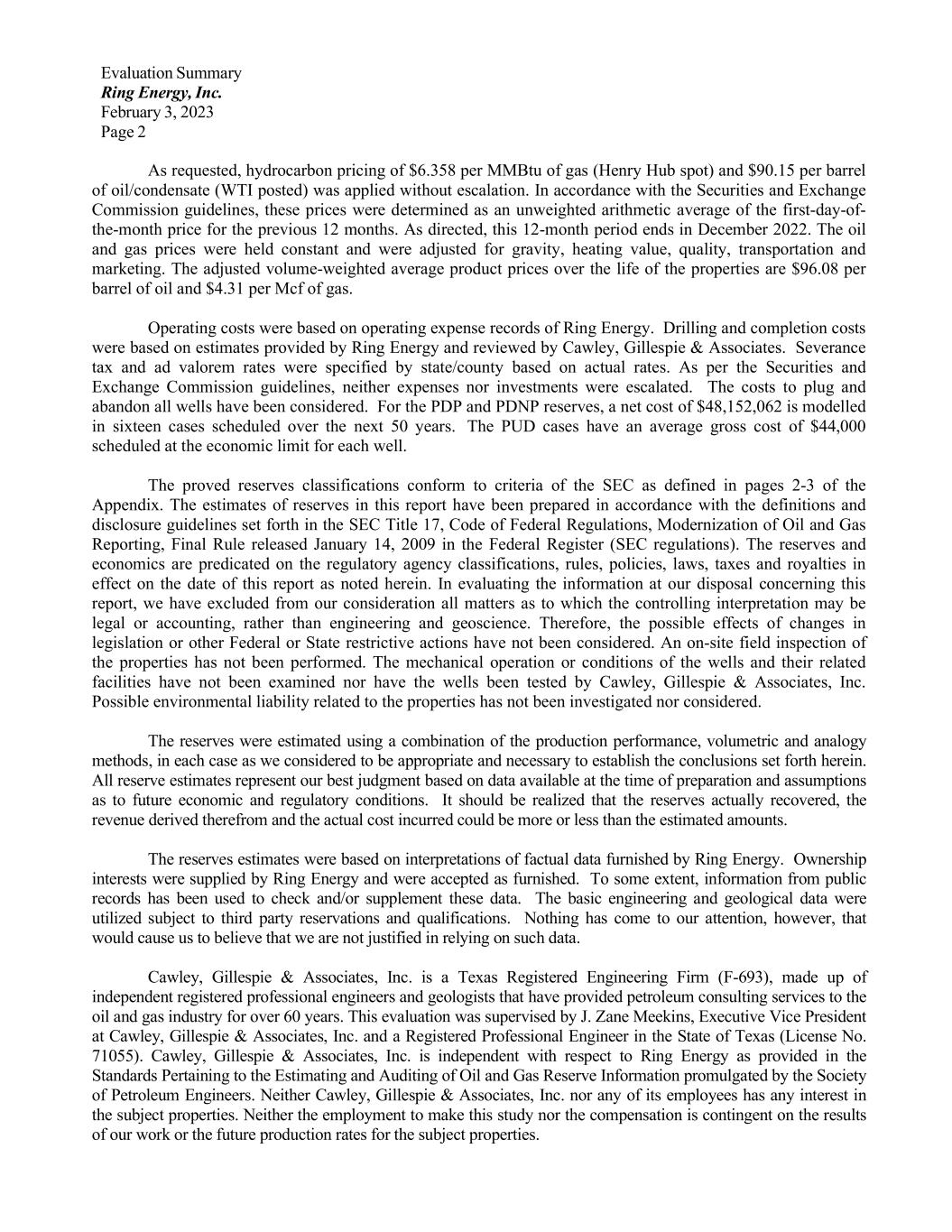
Evaluation Summary Ring Energy, Inc. February 3, 2023 Page 2 As requested, hydrocarbon pricing of $6.358 per MMBtu of gas (Henry Hub spot) and $90.15 per barrel of oil/condensate (WTI posted) was applied without escalation. In accordance with the Securities and Exchange Commission guidelines, these prices were determined as an unweighted arithmetic average of the first-day-of- the-month price for the previous 12 months. As directed, this 12-month period ends in December 2022. The oil and gas prices were held constant and were adjusted for gravity, heating value, quality, transportation and marketing. The adjusted volume-weighted average product prices over the life of the properties are $96.08 per barrel of oil and $4.31 per Mcf of gas. Operating costs were based on operating expense records of Ring Energy. Drilling and completion costs were based on estimates provided by Ring Energy and reviewed by Cawley, Gillespie & Associates. Severance tax and ad valorem rates were specified by state/county based on actual rates. As per the Securities and Exchange Commission guidelines, neither expenses nor investments were escalated. The costs to plug and abandon all wells have been considered. For the PDP and PDNP reserves, a net cost of $48,152,062 is modelled in sixteen cases scheduled over the next 50 years. The PUD cases have an average gross cost of $44,000 scheduled at the economic limit for each well. The proved reserves classifications conform to criteria of the SEC as defined in pages 2-3 of the Appendix. The estimates of reserves in this report have been prepared in accordance with the definitions and disclosure guidelines set forth in the SEC Title 17, Code of Federal Regulations, Modernization of Oil and Gas Reporting, Final Rule released January 14, 2009 in the Federal Register (SEC regulations). The reserves and economics are predicated on the regulatory agency classifications, rules, policies, laws, taxes and royalties in effect on the date of this report as noted herein. In evaluating the information at our disposal concerning this report, we have excluded from our consideration all matters as to which the controlling interpretation may be legal or accounting, rather than engineering and geoscience. Therefore, the possible effects of changes in legislation or other Federal or State restrictive actions have not been considered. An on-site field inspection of the properties has not been performed. The mechanical operation or conditions of the wells and their related facilities have not been examined nor have the wells been tested by Cawley, Gillespie & Associates, Inc. Possible environmental liability related to the properties has not been investigated nor considered. The reserves were estimated using a combination of the production performance, volumetric and analogy methods, in each case as we considered to be appropriate and necessary to establish the conclusions set forth herein. All reserve estimates represent our best judgment based on data available at the time of preparation and assumptions as to future economic and regulatory conditions. It should be realized that the reserves actually recovered, the revenue derived therefrom and the actual cost incurred could be more or less than the estimated amounts. The reserves estimates were based on interpretations of factual data furnished by Ring Energy. Ownership interests were supplied by Ring Energy and were accepted as furnished. To some extent, information from public records has been used to check and/or supplement these data. The basic engineering and geological data were utilized subject to third party reservations and qualifications. Nothing has come to our attention, however, that would cause us to believe that we are not justified in relying on such data. Cawley, Gillespie & Associates, Inc. is a Texas Registered Engineering Firm (F-693), made up of independent registered professional engineers and geologists that have provided petroleum consulting services to the oil and gas industry for over 60 years. This evaluation was supervised by J. Zane Meekins, Executive Vice President at Cawley, Gillespie & Associates, Inc. and a Registered Professional Engineer in the State of Texas (License No. 71055). Cawley, Gillespie & Associates, Inc. is independent with respect to Ring Energy as provided in the Standards Pertaining to the Estimating and Auditing of Oil and Gas Reserve Information promulgated by the Society of Petroleum Engineers. Neither Cawley, Gillespie & Associates, Inc. nor any of its employees has any interest in the subject properties. Neither the employment to make this study nor the compensation is contingent on the results of our work or the future production rates for the subject properties.
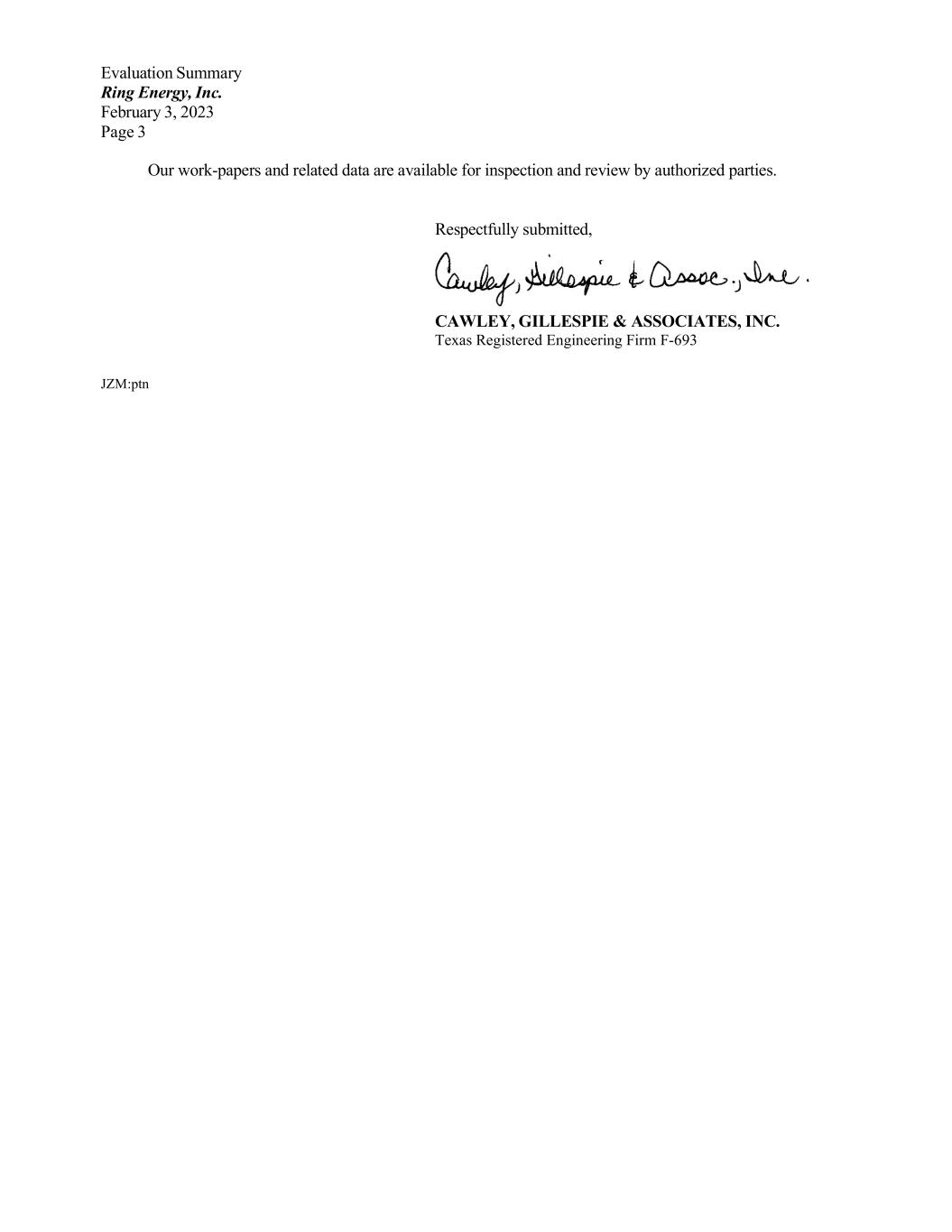
Evaluation Summary Ring Energy, Inc. February 3, 2023 Page 3 Our work-papers and related data are available for inspection and review by authorized parties. Respectfully submitted, CAWLEY, GILLESPIE & ASSOCIATES, INC. Texas Registered Engineering Firm F-693 JZM:ptn
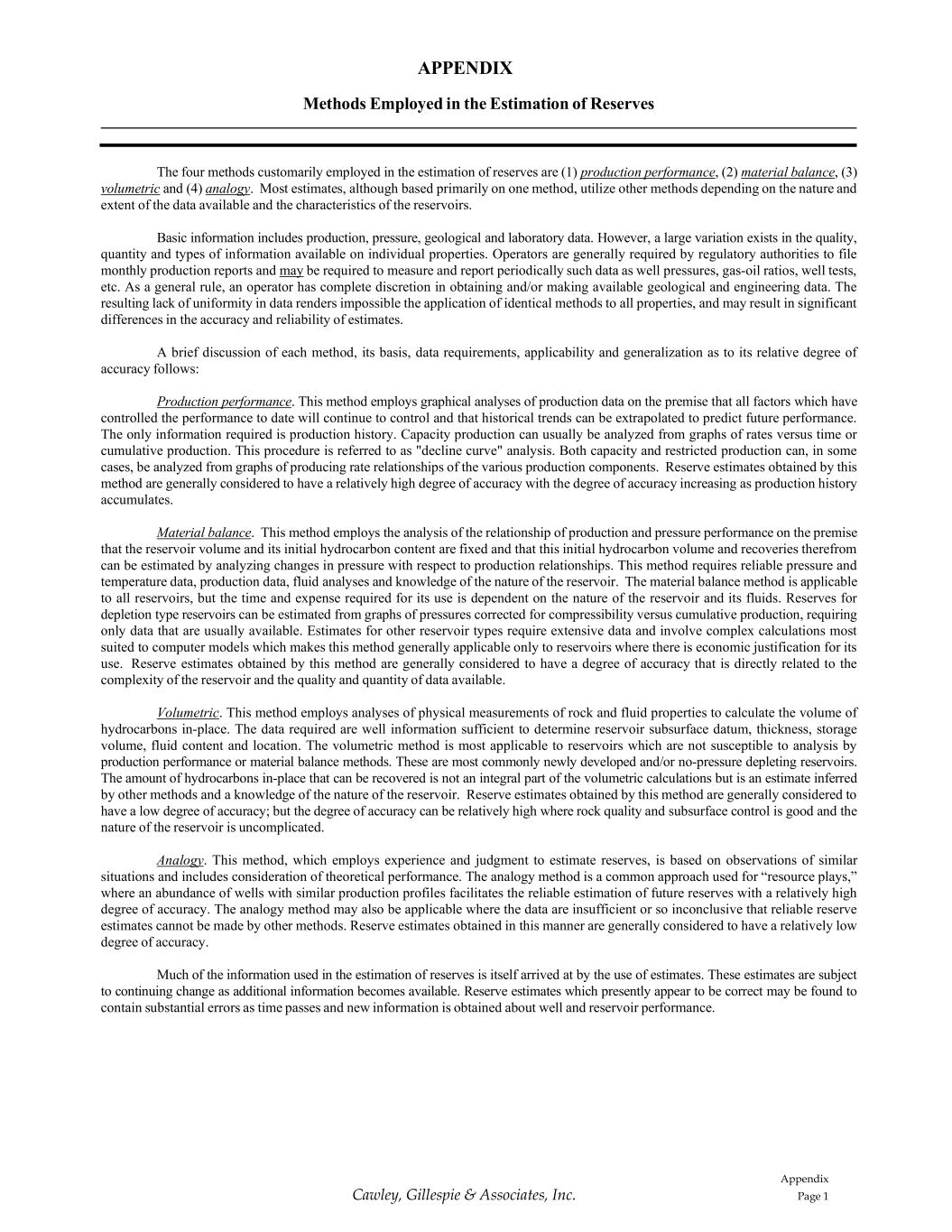
APPENDIX Appendix Page 1 Cawley, Gillespie & Associates, Inc. Methods Employed in the Estimation of Reserves The four methods customarily employed in the estimation of reserves are (1) production performance, (2) material balance, (3) volumetric and (4) analogy. Most estimates, although based primarily on one method, utilize other methods depending on the nature and extent of the data available and the characteristics of the reservoirs. Basic information includes production, pressure, geological and laboratory data. However, a large variation exists in the quality, quantity and types of information available on individual properties. Operators are generally required by regulatory authorities to file monthly production reports and may be required to measure and report periodically such data as well pressures, gas-oil ratios, well tests, etc. As a general rule, an operator has complete discretion in obtaining and/or making available geological and engineering data. The resulting lack of uniformity in data renders impossible the application of identical methods to all properties, and may result in significant differences in the accuracy and reliability of estimates. A brief discussion of each method, its basis, data requirements, applicability and generalization as to its relative degree of accuracy follows: Production performance. This method employs graphical analyses of production data on the premise that all factors which have controlled the performance to date will continue to control and that historical trends can be extrapolated to predict future performance. The only information required is production history. Capacity production can usually be analyzed from graphs of rates versus time or cumulative production. This procedure is referred to as "decline curve" analysis. Both capacity and restricted production can, in some cases, be analyzed from graphs of producing rate relationships of the various production components. Reserve estimates obtained by this method are generally considered to have a relatively high degree of accuracy with the degree of accuracy increasing as production history accumulates. Material balance. This method employs the analysis of the relationship of production and pressure performance on the premise that the reservoir volume and its initial hydrocarbon content are fixed and that this initial hydrocarbon volume and recoveries therefrom can be estimated by analyzing changes in pressure with respect to production relationships. This method requires reliable pressure and temperature data, production data, fluid analyses and knowledge of the nature of the reservoir. The material balance method is applicable to all reservoirs, but the time and expense required for its use is dependent on the nature of the reservoir and its fluids. Reserves for depletion type reservoirs can be estimated from graphs of pressures corrected for compressibility versus cumulative production, requiring only data that are usually available. Estimates for other reservoir types require extensive data and involve complex calculations most suited to computer models which makes this method generally applicable only to reservoirs where there is economic justification for its use. Reserve estimates obtained by this method are generally considered to have a degree of accuracy that is directly related to the complexity of the reservoir and the quality and quantity of data available. Volumetric. This method employs analyses of physical measurements of rock and fluid properties to calculate the volume of hydrocarbons in-place. The data required are well information sufficient to determine reservoir subsurface datum, thickness, storage volume, fluid content and location. The volumetric method is most applicable to reservoirs which are not susceptible to analysis by production performance or material balance methods. These are most commonly newly developed and/or no-pressure depleting reservoirs. The amount of hydrocarbons in-place that can be recovered is not an integral part of the volumetric calculations but is an estimate inferred by other methods and a knowledge of the nature of the reservoir. Reserve estimates obtained by this method are generally considered to have a low degree of accuracy; but the degree of accuracy can be relatively high where rock quality and subsurface control is good and the nature of the reservoir is uncomplicated. Analogy. This method, which employs experience and judgment to estimate reserves, is based on observations of similar situations and includes consideration of theoretical performance. The analogy method is a common approach used for “resource plays,” where an abundance of wells with similar production profiles facilitates the reliable estimation of future reserves with a relatively high degree of accuracy. The analogy method may also be applicable where the data are insufficient or so inconclusive that reliable reserve estimates cannot be made by other methods. Reserve estimates obtained in this manner are generally considered to have a relatively low degree of accuracy. Much of the information used in the estimation of reserves is itself arrived at by the use of estimates. These estimates are subject to continuing change as additional information becomes available. Reserve estimates which presently appear to be correct may be found to contain substantial errors as time passes and new information is obtained about well and reservoir performance.
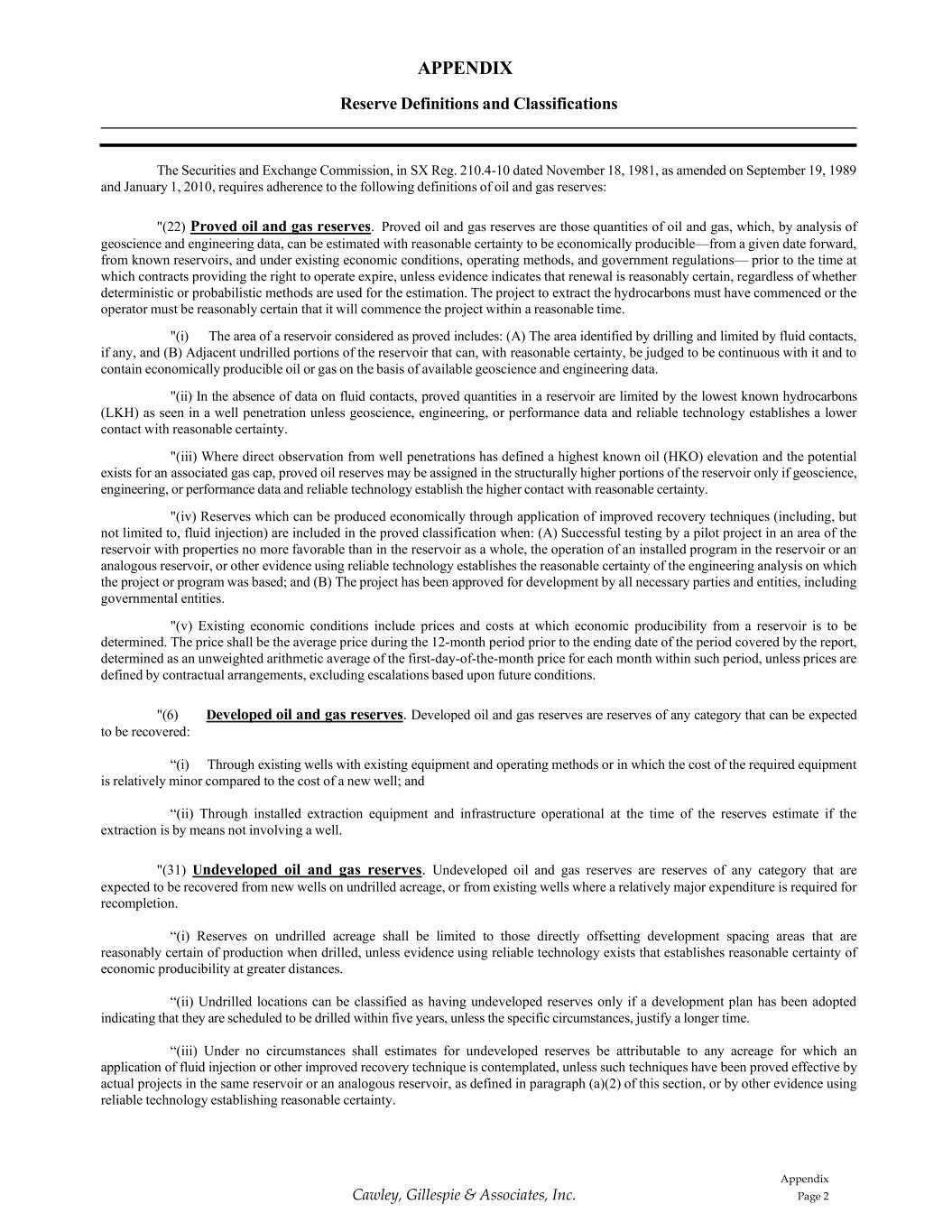
APPENDIX Appendix Page 2 Cawley, Gillespie & Associates, Inc. Reserve Definitions and Classifications The Securities and Exchange Commission, in SX Reg. 210.4-10 dated November 18, 1981, as amended on September 19, 1989 and January 1, 2010, requires adherence to the following definitions of oil and gas reserves: "(22) Proved oil and gas reserves. Proved oil and gas reserves are those quantities of oil and gas, which, by analysis of geoscience and engineering data, can be estimated with reasonable certainty to be economically producible—from a given date forward, from known reservoirs, and under existing economic conditions, operating methods, and government regulations— prior to the time at which contracts providing the right to operate expire, unless evidence indicates that renewal is reasonably certain, regardless of whether deterministic or probabilistic methods are used for the estimation. The project to extract the hydrocarbons must have commenced or the operator must be reasonably certain that it will commence the project within a reasonable time. "(i) The area of a reservoir considered as proved includes: (A) The area identified by drilling and limited by fluid contacts, if any, and (B) Adjacent undrilled portions of the reservoir that can, with reasonable certainty, be judged to be continuous with it and to contain economically producible oil or gas on the basis of available geoscience and engineering data. "(ii) In the absence of data on fluid contacts, proved quantities in a reservoir are limited by the lowest known hydrocarbons (LKH) as seen in a well penetration unless geoscience, engineering, or performance data and reliable technology establishes a lower contact with reasonable certainty. "(iii) Where direct observation from well penetrations has defined a highest known oil (HKO) elevation and the potential exists for an associated gas cap, proved oil reserves may be assigned in the structurally higher portions of the reservoir only if geoscience, engineering, or performance data and reliable technology establish the higher contact with reasonable certainty. "(iv) Reserves which can be produced economically through application of improved recovery techniques (including, but not limited to, fluid injection) are included in the proved classification when: (A) Successful testing by a pilot project in an area of the reservoir with properties no more favorable than in the reservoir as a whole, the operation of an installed program in the reservoir or an analogous reservoir, or other evidence using reliable technology establishes the reasonable certainty of the engineering analysis on which the project or program was based; and (B) The project has been approved for development by all necessary parties and entities, including governmental entities. "(v) Existing economic conditions include prices and costs at which economic producibility from a reservoir is to be determined. The price shall be the average price during the 12-month period prior to the ending date of the period covered by the report, determined as an unweighted arithmetic average of the first-day-of-the-month price for each month within such period, unless prices are defined by contractual arrangements, excluding escalations based upon future conditions. "(6) Developed oil and gas reserves. Developed oil and gas reserves are reserves of any category that can be expected to be recovered: “(i) Through existing wells with existing equipment and operating methods or in which the cost of the required equipment is relatively minor compared to the cost of a new well; and “(ii) Through installed extraction equipment and infrastructure operational at the time of the reserves estimate if the extraction is by means not involving a well. "(31) Undeveloped oil and gas reserves. Undeveloped oil and gas reserves are reserves of any category that are expected to be recovered from new wells on undrilled acreage, or from existing wells where a relatively major expenditure is required for recompletion. “(i) Reserves on undrilled acreage shall be limited to those directly offsetting development spacing areas that are reasonably certain of production when drilled, unless evidence using reliable technology exists that establishes reasonable certainty of economic producibility at greater distances. “(ii) Undrilled locations can be classified as having undeveloped reserves only if a development plan has been adopted indicating that they are scheduled to be drilled within five years, unless the specific circumstances, justify a longer time. “(iii) Under no circumstances shall estimates for undeveloped reserves be attributable to any acreage for which an application of fluid injection or other improved recovery technique is contemplated, unless such techniques have been proved effective by actual projects in the same reservoir or an analogous reservoir, as defined in paragraph (a)(2) of this section, or by other evidence using reliable technology establishing reasonable certainty.
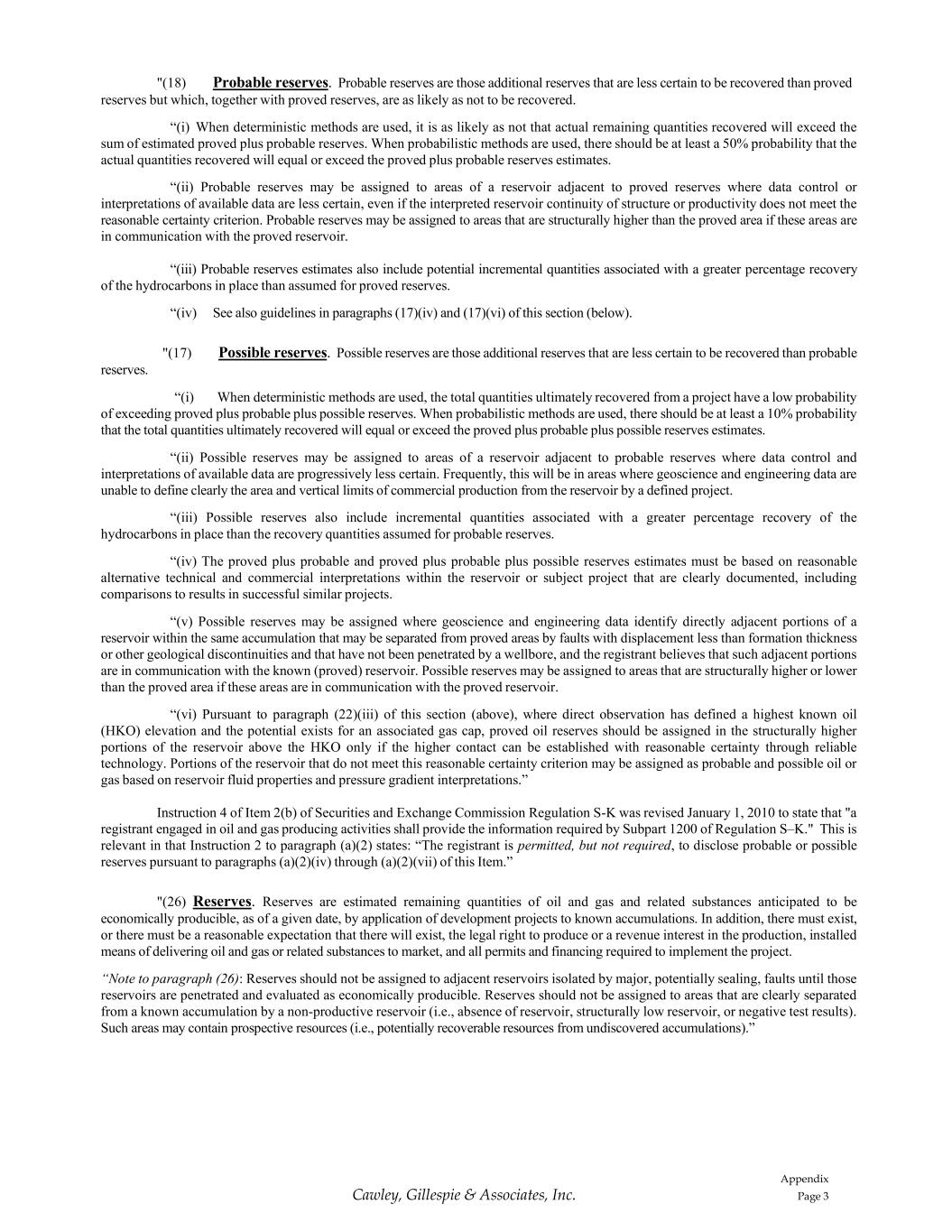
Appendix Page 3 Cawley, Gillespie & Associates, Inc. "(18) Probable reserves. Probable reserves are those additional reserves that are less certain to be recovered than proved reserves but which, together with proved reserves, are as likely as not to be recovered. “(i) When deterministic methods are used, it is as likely as not that actual remaining quantities recovered will exceed the sum of estimated proved plus probable reserves. When probabilistic methods are used, there should be at least a 50% probability that the actual quantities recovered will equal or exceed the proved plus probable reserves estimates. “(ii) Probable reserves may be assigned to areas of a reservoir adjacent to proved reserves where data control or interpretations of available data are less certain, even if the interpreted reservoir continuity of structure or productivity does not meet the reasonable certainty criterion. Probable reserves may be assigned to areas that are structurally higher than the proved area if these areas are in communication with the proved reservoir. “(iii) Probable reserves estimates also include potential incremental quantities associated with a greater percentage recovery of the hydrocarbons in place than assumed for proved reserves. “(iv) See also guidelines in paragraphs (17)(iv) and (17)(vi) of this section (below). reserves. "(17) Possible reserves. Possible reserves are those additional reserves that are less certain to be recovered than probable “(i) When deterministic methods are used, the total quantities ultimately recovered from a project have a low probability of exceeding proved plus probable plus possible reserves. When probabilistic methods are used, there should be at least a 10% probability that the total quantities ultimately recovered will equal or exceed the proved plus probable plus possible reserves estimates. “(ii) Possible reserves may be assigned to areas of a reservoir adjacent to probable reserves where data control and interpretations of available data are progressively less certain. Frequently, this will be in areas where geoscience and engineering data are unable to define clearly the area and vertical limits of commercial production from the reservoir by a defined project. “(iii) Possible reserves also include incremental quantities associated with a greater percentage recovery of the hydrocarbons in place than the recovery quantities assumed for probable reserves. “(iv) The proved plus probable and proved plus probable plus possible reserves estimates must be based on reasonable alternative technical and commercial interpretations within the reservoir or subject project that are clearly documented, including comparisons to results in successful similar projects. “(v) Possible reserves may be assigned where geoscience and engineering data identify directly adjacent portions of a reservoir within the same accumulation that may be separated from proved areas by faults with displacement less than formation thickness or other geological discontinuities and that have not been penetrated by a wellbore, and the registrant believes that such adjacent portions are in communication with the known (proved) reservoir. Possible reserves may be assigned to areas that are structurally higher or lower than the proved area if these areas are in communication with the proved reservoir. “(vi) Pursuant to paragraph (22)(iii) of this section (above), where direct observation has defined a highest known oil (HKO) elevation and the potential exists for an associated gas cap, proved oil reserves should be assigned in the structurally higher portions of the reservoir above the HKO only if the higher contact can be established with reasonable certainty through reliable technology. Portions of the reservoir that do not meet this reasonable certainty criterion may be assigned as probable and possible oil or gas based on reservoir fluid properties and pressure gradient interpretations.” Instruction 4 of Item 2(b) of Securities and Exchange Commission Regulation S-K was revised January 1, 2010 to state that "a registrant engaged in oil and gas producing activities shall provide the information required by Subpart 1200 of Regulation S–K." This is relevant in that Instruction 2 to paragraph (a)(2) states: “The registrant is permitted, but not required, to disclose probable or possible reserves pursuant to paragraphs (a)(2)(iv) through (a)(2)(vii) of this Item.” "(26) Reserves. Reserves are estimated remaining quantities of oil and gas and related substances anticipated to be economically producible, as of a given date, by application of development projects to known accumulations. In addition, there must exist, or there must be a reasonable expectation that there will exist, the legal right to produce or a revenue interest in the production, installed means of delivering oil and gas or related substances to market, and all permits and financing required to implement the project. “Note to paragraph (26): Reserves should not be assigned to adjacent reservoirs isolated by major, potentially sealing, faults until those reservoirs are penetrated and evaluated as economically producible. Reserves should not be assigned to areas that are clearly separated from a known accumulation by a non-productive reservoir (i.e., absence of reservoir, structurally low reservoir, or negative test results). Such areas may contain prospective resources (i.e., potentially recoverable resources from undiscovered accumulations).”